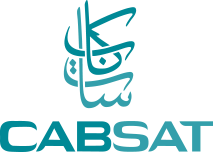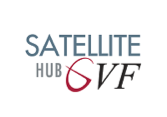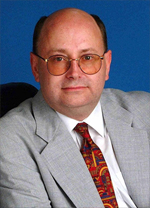Martin Jarrold, Chief of International Programme Development, GVF and Chair, Satellite Hub Summit @ CABSAT 2017 | Chair, SATEXPO @ CABSAT 2017 gives an outlook of the upcoming conference.
 CABSAT has a new conference dimension this year. Not only will the exhibition be augmented by the regular feature of the GVF Satellite Hub Summit, but also by a new feature, SATEXPO. The organising partnership of GVF and Dubai World Trade Centre (DWTC) will therefore present a three-day programme of strategic debate on key issues for the current satellite industry technology and service marketplace as an added-value facet of the exhibition.
CABSAT has a new conference dimension this year. Not only will the exhibition be augmented by the regular feature of the GVF Satellite Hub Summit, but also by a new feature, SATEXPO. The organising partnership of GVF and Dubai World Trade Centre (DWTC) will therefore present a three-day programme of strategic debate on key issues for the current satellite industry technology and service marketplace as an added-value facet of the exhibition.
SATEXPO and the Hub Summit will comprise mutually-reinforcing programmes of satellite sector and satellite solutions end-user perspectives, with a day one emphasis on strategic analysis of various user markets and a day two and day three focus on interactive panel sessions which will offer detailed examination of core themes within today’s industry environment, such as satellite spectrum, high throughput satellite technologies, low earth orbit satellite constellations, the VSAT mobility market, satellite interference, satellites and emergency response, and cyber security.
The first of CABSAT’s three exhibition days (21st March) will feature SATEXPO which I will have the pleasure of chairing. SATEXPO will explore solutions & technologies for the MENA region, encompassing applications in satellite communications, earth observation, satellite imagery, hybrid network technologies, mobile satellite services & security, and space.
 I have the equal pleasure of chairing both days of the Hub Summit (22nd & 23rd March) and will be working alongside a wealth of panel session moderating expertise and satellite industry knowledge – the line-up including Stéphane Chenard, Senior Analyst, Euroconsult; Virgil Labrador, Editor-in-Chief, Satellite Markets & Research; Torsten Kriening, Editor, SpaceWatch Middle East; Kevin French, Publisher, talk Satellite; and, Riaz Lamak, Lead, International Programmes, GVF.
I have the equal pleasure of chairing both days of the Hub Summit (22nd & 23rd March) and will be working alongside a wealth of panel session moderating expertise and satellite industry knowledge – the line-up including Stéphane Chenard, Senior Analyst, Euroconsult; Virgil Labrador, Editor-in-Chief, Satellite Markets & Research; Torsten Kriening, Editor, SpaceWatch Middle East; Kevin French, Publisher, talk Satellite; and, Riaz Lamak, Lead, International Programmes, GVF.
An exploration of MENA’s regional telecommunications market dynamics is the starting theme for the first day of the Hub Summit. This opening session will provide an overview of current key dynamics & forecasts for near- and medium-term evolution across the Middle East and North African telecommunications sector and analyse the ongoing major & expanding role of the satellite solution.
Spectrum: Satellite & the Next ITU World Radiocommunication Conference will be the following theme, addressing the next phase of the radio frequency spectrum allocation dynamic. Agreements reached by national administrations at the last WRC, in 2015, reflected a comprehensive strategy in which the unique value proposition of satellite-based connectivity is an integral part of a portfolio of synergistic technologies. The next conference, WRC-19, is already looming on the horizon, and so this session will take a strategic overview of the key agenda points in which the providers of satellite-based communications technology and service solutions have a vital interest.
High throughput satellites (HTS) maintain top-billing on the industry agenda. Leveraging Advancing Technologies & Scaling Innovative Services to Evolve Larger & Emergent Markets will address this. With the advantages of HTS over traditional fixed satellite service (FSS) now clearly recognised as including considerable reduction in the average cost per Gbps (gigabit per second) of bandwidth in orbit, the session dialogue will encompass such questions as: “The Operators… What is their new focus from orbit?”… “What are the new challenges, in the new markets?”… “What are the evolved dynamics for ground segment?”… “Is Mobility All That Matters Now?”… and, “Is the value-chain being reinvented?” The discussion will also cover the A… B… C… of growth, with Aeronautical, Backhaul & Consumer Broadband having been recognised as key applications stimulating continued HTS market expansion.
With the aeronautical market being subject to detailed analysis on Day Two of the Satellite Hub Summit programme, this session will also focus on the satellite industry’s capabilities and further potential to deliver on the kind of advances necessitated by the backhauling requirements of the wireless data environment, including the provision of enhanced clarity in its value proposition, using the language of the wireless sector, and, as wireless continues to advance through successive technology generations, to deliver clear technology upgrade paths.
In Constellations for Connectivity: The Low Earth Orbit Solution Re-born? discussion will address the myriad of questions that have arisen since the OneWeb, SpaceX and LeoSat announcements. “How will the HTS and Mega-LEO services compete… or will they be complementary?” “How will they be differentiated and priced?” “How will they be contracted and regulated?” “How are the new constellations going to be launched?” “How will the systems satisfy end-user requirements?” “Who will come out on top?” Not just among the satellite operators, but everyone in the value chain: Manufacturers, integrators, network licensees and, ultimately, the users – wireless operators, maritime & aeronautical interests, oil & gas companies, military, civil government agencies, and not least the individual consumer. The dialogue will also ask “Just what are the mobility and interference challenges?” and “Are New Apps Driving New Satellite Designs?”
Effective communications are essential to humanitarian emergency operations, and the session Mission Criticality: The Satellite Solution & the Humanitarian Crisis will explore the ecosystem of the Crisis Connectivity Charter. The Charter is a set of commitments to enhance communications in times of crises. It was signed by the satellite operators and integrator community and the United Nations in October 2015, and was established by the EMEA Satellite Operators’ Association (ESOA) and the GVF with the support of the United Nations World Food Programme (WFP)-led Emergency Telecommunications Cluster (ETC) – of which GVF is a full member – and the UN Office for the Coordination of Humanitarian Affairs (OCHA). It provides ETC responders with the skills and experience to deploy, manage and support satellite solutions, facilitated through the Crisis Connectivity Charter, during humanitarian emergency operations.
 Day Two of the GVF Satellite Hub Summit @ CABSAT 2017 (23rd March) begins with Into the Mainstream: VSAT Communications-on-the-Move & the New Strategic Marketplace. This panel session will address the communications on the move (COTM) ecosystem and the emergent rapid growth of the aeronautical connectivity market and its inter-relationship with further growth of high throughput satellite system deployments, together with analysis of the increasing demand for high-performance satellite communications on the move (SOTM) earth stations and the industry’s endeavours to improve the way that terminal specifications, testing, and approvals are applied, aiming to achieve breakthroughs which reduce product solutions ‘time to market’.
Day Two of the GVF Satellite Hub Summit @ CABSAT 2017 (23rd March) begins with Into the Mainstream: VSAT Communications-on-the-Move & the New Strategic Marketplace. This panel session will address the communications on the move (COTM) ecosystem and the emergent rapid growth of the aeronautical connectivity market and its inter-relationship with further growth of high throughput satellite system deployments, together with analysis of the increasing demand for high-performance satellite communications on the move (SOTM) earth stations and the industry’s endeavours to improve the way that terminal specifications, testing, and approvals are applied, aiming to achieve breakthroughs which reduce product solutions ‘time to market’.
In the aeronautical space, GVF has worked with the Airline Passenger Experience Association (APEX) to examine the “in-flight online revolution”, focusing on the very latest developments in the new broadband communications dimension to contemporary commercial air travel. The airliner seat is becoming a fully functioned extension of the office desk and domestic living room, with the passenger as consumer of in-flight entertainment and connectivity (IFEC). Additionally, the airline carrier (and its employees) are also users within the new paradigm of the in-flight connectivity ecosystem which is enabled by the greater availability of broadband satellite capacity over the world’s commercial air corridors.
The next panel will look at Ensuring an Interference-Free World of Satellite Services, and explore radio frequency interference issues, causes and solutions from both proactive and reactive perspectives. Specifically the session will offer analysis from the perspectives of: Personnel: Installation Training & Certification; Equipment: Product Quality Assurance; Signal Tracking: Carrier ID (CID); and, Deliberate Interference: The ITU; Arab Broadcasters Implementing MENA Solutions
In 2014, the GVF commissioned a Cyber Security Task Force (CSTF). It comprised security experts and representatives from across the satellite industry and had the goal to create a set of vendor-neutral specifications for the industry that would enhance security without reducing the utility and performance of VSAT solutions. The penultimate session for day two, entitled Integrating & Securing Our Digital World: Cyber Security for Satellite in a World of Big Data, the IoT & the Cloud, will follow-on from a Satellite Industry Association (SIA) and GVF joint statement on the satellite industry’s commitment to cyber security which articulates core principles for cyber security, encouraging all segments of the satellite industry to continue efforts to address the dynamic challenge of cyber security and emphasising the criticality of cyber security to the satellite industry’s core goal of providing mission critical, highly reliable, and secure connectivity.
The final Hub Summit session, Perspectives & Strategic Take-Aways: The Satcoms Dynamics of a Connected World, comprises an open forum where speakers, moderators and attendees will have the opportunity to engage in a frank and open dialogue about the key points raised during the two-days of Hub Summit discussions, and will provide attendees with key take-aways on which to further reflect.
At time of writing, some two months ahead of CABSAT 2017, the Hub Summit programme has already attracted the speaking participation of (in alphabetical order): ArabSat, Fraunhofer IIS, Intelsat, International Telecommunication Union, LeoSat, Satellite Applications Catapult, Satellite Interference Reduction Group, SES, Talia, and Thaicom. This represents just the beginning of an exciting and insightful line-up.
GVF is the single and unified voice of the global satellite industry. Founded in 1997, it brings together organisations engaged in the delivery of advanced broadband and narrowband satellite services to consumers, and commercial and government enterprises worldwide. Headquartered in London, GVF is an independent, non-partisan and non-profit organisation with 200+ members from more than 100 countries. The broad-based membership represents every major world region and every sector of the satellite industry, including fixed and mobile satellite operators, satellite network operators, teleports, satellite earth station manufacturers, system integrators, value added and enhanced service providers, telecom carriers, consultants, law firms, and users. Contact [email protected] in the UK office, or in the US office please contact [email protected] or [email protected].
 Martin Jarrold was appointed GVF Chief of International Programme Development in June 2001. His responsibilities include outreach to the members of GVF and the further development of the profile of the Forum within the satellite communications industry, and across the global telecommunications policy and regulatory community, and extending the understanding of, and promoting the use of, satellite-based communications in various key end-user vertical markets.
Martin Jarrold was appointed GVF Chief of International Programme Development in June 2001. His responsibilities include outreach to the members of GVF and the further development of the profile of the Forum within the satellite communications industry, and across the global telecommunications policy and regulatory community, and extending the understanding of, and promoting the use of, satellite-based communications in various key end-user vertical markets.
Original published at: http://spacewatchme.com/2017/01/spacewatchme-forecast-the-conferences-of-cabsat-2017/
 SpaceWatch.Global An independent perspective on space
SpaceWatch.Global An independent perspective on space

